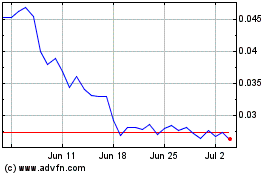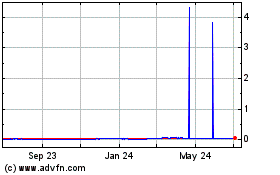GameFi and NFT: What Projects Will Blow up the Industry in 2022
January 31 2022 - 5:35AM
NEWSBTC
A multibillion GameFi and blockchain games market is named as one
of the major trends of 2022 that promises many opportunities both
for players and investors. Yet, so far the market is so fragmented
and chaotic that it is hard to grasp how to profit from this trend.
To succeed in this fast-growing field, one must know the secrets of
the GameFi industry. How is GameFi different from online games?
GameFi is a new niche in the blockchain industry at the nexus of
two fields – decentralized finance and decentralized games. GameFi
is far from being a simple online game. GameFi are gaming platforms
that allow users to get profits in digital coins from gaming. On
one side, it improves user retention rates, on the other – it helps
users earn real money within a game. To start gaming and earning, a
user has to buy a character or a gaming asset that is presented in
the form of a non-fungible token – NFT. Largely owing to GameFi,
the NFT market has achieved such unprecedented growth rates in
2021. According to the DappRadar statistics, the non-fungible
tokens trading volumes have grown hundreds of times – from $100
million in 2020 to $23 billion in 2021. The lion’s share of
those trading operations accounts for gaming NFT. In November 2021,
trading volumes of gaming NFT exceeded $1 billion by almost
doubling its growth rates in one month, in comparison with October
2021. This economic model for decentralized online games was dubbed
the Play-to-Earn model. Essentially, NFT is a sort of a
subscription to enter the game. By purchasing NFT, users get an
opportunity to access a multiplayer online game, interact with
other players and most importantly – get profits from participating
in the game. Where is the liquidity coming from in GameFi? When a
user bought the subscription for the game, for example, for the
football simulator FIFA, it was enough to pay once. After the
purchase, a user could play at any moment. In the GameFi game that
requires buying gaming NFTs, the basic principles are different. In
decentralized online games, users need to buy gaming items and
characters. For example, if once-popular casual game FarmVille were
an NFT-based game, a gamer would not get a piece of land and seeds
for free. In that game, users would have needed to purchase them to
harvest crops. At the same time, there is also good news: in
GameFi, users also have the opportunity to earn money on their
gaming items. If one is good at harvesting crops, one would be able
to sell them and get a return on the investment in land and seeds.
Since NFT games emerged and have grown on the fertile lands of the
cryptocurrency market, all transactions involving gaming items in
the form of non-fungible tokens are executed in cryptocurrencies.
In this way, the gaming ecosystem is being filled with liquidity
that allows the use of the Play-to-Earn model. Up to $400 monthly
for a few hours in the online game Profits in GameFi projects come
from several sources: Gaming NFT, the value of which is a couple of
dollars, when the sales start, and after the inflow of new players
rockets to hundreds and tens of thousands dollars. Rewards for
performing gaming tasks: for example, winning over other players in
battles of completing quests. Investments in the native token of a
GameFi project that serves as a currency for rewards, purchase and
sale transactions of gaming items and characters. Already from the
description, it is obvious that the first two sources of income are
oriented at gamers while the third one is for investors that see
GameFi projects as one of the passive income sources and that do
not actively participate in the game itself. Yet, in the real-case
scenario, also the first profit source which is gaming NFT in the
leading games is accessible only to investors or gamers with high
levels of income since its value can reach hundreds and tens of
thousands of dollars. So at the end of 2021, the average price for
the NFT character of the popular decentralized game Axie Infinity
has reached $140. According to projections, in 2022, it will grow
to $219. This being said, to start a game, a gamer needs three
characters. In that way, the initial investment to start a game is
$420. Of course, it significantly exceeds the subscription price
levels for centralized multiplayer online games. Not every online
gamer can spare such funds to access the game. Statistical data
shows the majority of the GameFi games are from the poorest
countries where earning on Play-to-Earn games could bring a
substantial plus to the average paycheck. Of course, for them, the
high initial investment is a serious barrier. As a result, NFT
characters get settled in the hands of investors that would like to
earn money but have no time to complete daily gaming tasks while
the platform lacks active users. Investors also are not using the
GameFi market to its potential since they do not earn from the
game, do not get rewards for completing daily tasks. To solve this
problem a market needs additional services. One of such
infrastructure projects created for the development of blockchain
applications is the p2p platform MetaRent by Meta DAO Guild. What
is Meta DAO Guild? Meta DAO Guild is a decentralized autonomous
organization that executes several infrastructure projects in the
P2E games industry and that offers an elegant solution to two main
GameFi problems: Investors’ problem: they have money and they would
like to profit from it but they have no time to spare on a game.
Gamers’ problem: they have time to spare but have no money to buy a
costly NFT character to access a game. The solution to both
problems lies at the surface. If users have no time to play a game
or would like to spend free time on another game, they could lease
out their NFT. On the other hand, users with no money to buy NFT
can rent other persons’ characters and access the same. This is
exactly a type of p2p-platform for renting gaming NFT named
MetaRent that Meta DAO Guild is creating. Profits from gaming are
distributed among the player and the owner of the gaming token.
This solves the problem of idle gaming NFTs. At the same time, the
platform is offering instruments that guarantee the safety of the
deal for both sides. How does the platform work? The NFT owner
registers on the platform and selects gamers from the scholars
(gamers that were trained by Meta DAO Guild). While leasing out
NFT, its owner shares half of the profits with a gamer. The lessee
(a gamer) gets access to gaming NFT without initial investments.
The platform MetaRent from Meta DAO Guild ensures with smart
contracts that the NFT owner shares its profits with the lessee. To
avoid a possibility of fraud, Meta DAO Guild takes on a mandatory
deposit from an NFT owner. In other words, the investor has to put
on a deposit to lease out the NFT. The deposit serves as a
guarantee that a gamer will be paid. Of course, NFT owners risk
facing an inexperienced player that might waste time and bring no
returns. That is why Meta DAO Guild is creating an educational
system and ranking mechanism for gamers. The investors have the
right to choose the best among free players for leasing out their
NFTs. The full list of services by Meta DAO Guild includes:
MetaRent: p2p-platform for renting out gaming NFT; Scholarship: an
educational system for gamers – members of the DAO Guild, that rent
gaming assets owned by the guild (community) and external owners;
MetaExchange: exchange service for gaming NFTs that allow changing
non-demanded gaming items or characters (which is hard to sell)
within one game or among games; DAO Launchpad: the decentralized
venture fund for investments in GameFi projects. The latter –
DAO Launchpad – deserves special attention. As the name
implies, the fund is being governed as a decentralized autonomous
organization – in other words, by users themselves. Users must own
native platform tokens MDGG to get rights for voting on choosing
GameFi projects for investment. The participation in DAO Launchpad
provides a regular user with multiple advantages. First of all, it
opens up possibilities to invest in promising GameFi projects at
early stages when there is still no access for retail investors. At
this stage, investors are offered the best terms while the
profitability of the bought tokens or coined NFTs might reach 1000%
in a couple of years. For example, in summer 2020, Axie Infinity
sold 10 800 000 AXS tokens for $860 000 during the closed
investment round. In that way, one AXS cost 8 cents for early
investors. Now AXS is traded for $52 while in Autumn it rocketed up
to $102. In October 2021, ROI for sold tokens was 1200х, in January
2022 – 650х. DAO Launchpad provides an opportunity for gaming
projects not only to get investments but also to access the engaged
gaming community of the Meta DAO Guild. Investors that are
interested in projects that are building the GameFi industry
infrastructure have an opportunity to purchase Meta DAO Guild
tokens MDGG during the Private Sale that starts on February 22. Why
will GameFi grow? For understanding GameFi perspectives, it is best
to use real-life examples. Last year, the Philippine CNN office
shared that citizens of the Philippine Province of Nueva Ecija are
earning by playing NFT games. Thanks to a decentralized online game
that gives an opportunity to earn income, citizens could pay for
food, medicine, bills — even close their loans — even though the
pandemic took their jobs. Like DeFi in 2021, GameFi has all chances
to become the main trend of 2022. The niche is swiftly being
inflated with liquidity – both from users and institution-level
investors. In the second half of 2021, multi-billion funds were
created for investing in GameFi projects at early stages. For
example, Gala Games together with C2 Ventures launched a venture
fund for GameFi for $100 million, Solana Ventures, Forte, and
Griffin Gaming Partners created a $150 million fund. The valuation
of the Hongkongese company Animoca Brands which works with
blockchain games and NFT has skyrocketed to $5 billion at the last
investment round. In 2022, hundreds of new decentralized games are
expected to be launched on the GameFi market. But the most
important thing is that this year major gaming companies-developers
are entering the Game Fi niche. It is reasonable to expect user
experience improvements due to more elaborated gaming scenarios,
in-depth sound character design, and visual components
enhancements. But the main growth driver is the inflow of millions
of users into GameFi. Thanks to the new economic model Play-to-Earn
gamers have an opportunity to earn while gaming. This is exactly
why projects in this industry are ready to show many-fold profits
despite the volatility of cryptocurrencies.
Gala (COIN:GALAUSD)
Historical Stock Chart
From Oct 2024 to Nov 2024

Gala (COIN:GALAUSD)
Historical Stock Chart
From Nov 2023 to Nov 2024
